#dynamicmetadata
Explore tagged Tumblr posts
Text
What's the difference between HD, UHD, 4K and 8K?

The rapid development of technology has opened up new opportunities for a significant increase in the TV diagonal without a sharp increase in their price. As a result, today the market offers relatively affordable models even with a diagonal of 65" and more. As known, image clarity and detail depends on the pixel size. But their visualization is limited by physiological features of vision. For example, most people don't perceive the difference between Full HD and Ultra HD formats for TVs with a diagonal of less than 55". But this difference is clearly visible on a TV screen with a diagonal of 65" and above. As known, the optimal viewing distance depends on the screen diagonal.

Usually, TV for the kitchen has a small diagonal and does not require high resolution. According to some experts, the visualization of the difference for 4K begins with a diagonal size of 70" when viewed from an optimal distance. According to some people, they perceive the difference in resolution even on 32" TVs. But according to ophthalmologists, this is possible only for people with very sharp eyesight. Most likely, this visualization is caused by a psychological aspect. Of course, companies take this aspect into account and produce high-resolution models only for sufficiently large matrices from 55" and above. But the resolution affects not only the image clarity. For example, 4K increases the viewing angle and reduces the optimal distance to 1.5 screen heights, expanding the choice of a comfortable viewing point. The 8K increases the viewing angle to 120 degrees and reduces the minimum distance to 3/4 of the screen height, increasing the presence effect when viewing.
Classification
In fact, 4K UHD TV can be positioned as an intermediate standard between HDTV and 8K UHD TV. Compared to HD, it enhances clarity four times, expands the dynamic range of color rendering and provides 24-channel sound. For comparison, HD TV provides only 6-channel sound. Therefore, in recent years, segment leaders have concentrated a significant part of their efforts in this direction. As a result, in a relatively short time, companies have filled the market with HD, UHD, 4K models and even presented 8K TVs. Unfortunately, any dynamic process is often accompanied by a confusion of concepts and terms. In addition, the marketing component also exacerbates the situation. Therefore, even a simplified classification will help to understand this issue. As known, the screen resolution is measured in pixels of the matrix vertically and horizontally. American ATSC, European ETSI and, accordingly, TV manufacturers use the following standards for high-definition television: - 720p - resolution of 1280 x 720 pixels, progressive scan, 50 or 60 Hz, aspect ratio of 16: 9; - 1080i - resolution of 1920 x 1080 pixels, interlace scan, aspect ratio of 16: 9, 50 or 60 half-frames per second, which corresponds to 25 or 30 fps; - 1080p - resolution of 1920 x 1080 pixels (2.07 MPix), progressive scan, 16: 9 frame format, 24, 25, 30, 50, 60 fps; - 2160p - resolution of 3840 x 2160 pixels (8.8 MPix).

Some key features
American NTSC and European PAL and SECAM systems are the main standards for television signal transmission. The American system uses 525 lines, and the European systems use 625 lines. This distinction arose in the era of the birth of television and has not changed since. But in reality, the TV used only 576 lines to form an image due to the retrace of the beam between the deflecting coils. This 720 x 576 resolution has been preserved for digital television in SD (standard definition). The frame rate was chosen depending on the frequency in the power supply network and was 50 Hz for Europe and 60 Hz for America that simplifies matching TV sweep generator to the mains. Of course, modern digital models do not have such limitations due to the lack of a traditional CRT. The new HD TV standard uses only digital transmission of television signals and does not require a line for service impulses. Therefore, the TV uses all the lines to form an image. This standard contains 720 or 1080 lines, 50 or 60 Hz frame rate, interlace (“i”) or progressive (“p”) scan. Progressive scan simultaneously uses all the lines to form an image. Interlace scan alternates even and odd lines in each half frame, which slightly distorts the image.

Therefore, progressive scan delivers better quality and dominates today. List of TV standards includes: - LD TV - low definition, 240p, 288p; - SD TV - standard definition, 480i - NTSC, 576i - PAL; - ED TV - enhanced definition, 480p, 576p, 720p; - HD TV - high definition, 1080i, 1080p; - 4K UHD TV - ultra-high definition, 2160p; - 8K UHD TV (Ultra High Definition Television) - ultra-high definition, 4320p.
4K, Ultra HD and Full HD

Modern matrices support: - Standard Definition (SD) - 720 x 576 pixels, aspect ratio 16: 9; - High Definition (HD) or Full HD (2K) - 1920 x 1080 pixels, aspect ratio 16: 9. HD TV was introduced along with H.264 codec; - Ultra HD (UHD) - 3840 x 2160 pixels, 8 MPix for the entire matrix, 16: 9; High Efficiency Video Codec (HEVC) H.265. As known, the more efficient H.265 uses coding tree units (CTU) instead of macroblocks, reducing channel width requirements.

The number of pixels for UHD is double the Full HD horizontally and vertically. Accordingly, the excess of the total number of pixels reaches a factor of 4. As a result, even a huge display provides high definition due to the reduction in the size of each pixel.

- 4K UHD or UHD-1 or 2160p, full-frame - 3996 x 2160 pixels, 12 MPix, 4:3; High Efficiency Video Codec (HEVC) H.265; Digital Cinema Initiatives (DCI) uses 4K with a resolution of 4096 x 2160 pixels and an aspect ratio of 17: 9. - 4K (cache) - 3996 x 2160 pixels, 8,5 MPix, High Efficiency Video Codec (HEVC), H.265; Flat (1,85:1). As known, Flat and Scope are the standards for widescreen aspect ratio for digital cinema. - 8K or Full HD Ultra or UHD2– 7680 х 4320 pixels, 34 MPix, Super Hi-Vision System (SHV). Japan (NHK) announced the introduction of the 8K standard by 2020. As known, LG for the first time demonstrated 8K OLED TV at IFA 2018.

Conclusion
Of course, playback in 4K format requires appropriate content. Unfortunately, it lags far behind the hardware capabilities of modern TVs. 4K signal has a high density and requires complex processing. As a result, it can be interrupted during the playback of highly dynamic scenes. Therefore, this format requires increased frequency. For example, shooting the UHD resolution content requires a frequency of 120 Hz. Of course, the transfer of such a information volume dramatically increases the requirements for bandwidth and storage. For example, the amount of video information of a movie in Full HD-resolution varies from 20 or 40 GB. For comparison, a similar film in UHD requires from 80 to 160 GB. Of course, such information volume significantly limits online viewing. In addition, very popular HDR technology also actively influences the prospects for further development in this segment. As known, HDR technology today contains HDR10, HDR10 + and Dolby Vision standards. But if the HDR10 uses only static metadata, then HDR10 + and Dolby Vision require the transmission of dynamic metadata. Of course, the metadata for each frame dramatically increases the information volume and bandwidth requirements. Today, HDR10 is supported by HDMI 2.0 models with transfer only static matadata. However, HDR video content with dynamic metadata requires HDMI 2.0a or HDMI 2.1. As you know, LG at CES 2019 first introduced 65C9 OLED TV with HDMI 2.1 support.

In general, of course, resolution is one of the main criteria for choosing a TV. This video offers comparison 8K vs 4K vs HD resolution. Read the full article
#4KUHD#65C9OLEDTV#8K#codingtreeunits#CTU#DolbyVision#dynamicmetadata#FullHD#FullHDUltra#H264#H265#HDMI2.0a#HDMI2.1#HDR10#HEVC#HighEfficiencyVideoCodec#interlacescan#progressivescan#SHV#staticmatadata#SuperHi-VisionSystem#UHD-1#UHD2
0 notes
Text
HDR technology

High Dynamic Range provides better contrast, greater brightness levels and a wider colour palette compared to traditional technology. According to many experts, HDR technology was the first significant leap after the advent of HDTV instead of SD. The development and implementation of this technology has become a logical continuation of the rapid development of television technology. Strong competition and the development of digital technologies have stimulated the technical development of TVs. As a consequence, companies created new matrix generation, including OLED, the high-performance video processors and new technologies, including FALD backlighting. These new TVs processed video signals at a fundamentally new level, providing a revolutionary improvement in image quality. But, unfortunately, the traditional standards of 8-bit color limited new possibilities. Of course, this situation could not last long. As a result, in 2012, Dolby Labs offered an elegant solution to this problem, increasing the dynamic range of the image brightness to 12 bits. As known, this value directly affects the number of displayed colors and their shades.

Of course, increasing the number of bits significantly expands the color gamut.

Accordingly, Dolby Vision became the first format for HDR. But this situation did not suit many market leaders and they began to develop their own alternative standards. Of course, such a development was unlikely to have prospects due to the complete absence of unification. Therefore, LG, Samsung, Sharp, Sony and Vizio have joined forces and created an open source HDR standard. In April 2016, the UHD Alliance industry group, including LG, Samsung, Sony, Panasonic, Dolby, etc announced the adoption of Ultra HD Premium certification for UHD Blu-ray players.
Operation principle
The scheme perfectly illustrates the essence of this technology, which uses the expansion of the color palette to increase the image saturation.

Of course, the image quality in this format is radically superior to the traditional format.

The image quality mainly depends on the contrast (the ratio of the brightest and darkest points on the screen) and color rendering (color palette, color gamut). Of course, the matrix resolution, viewing angles, fps of video, sound quality, refresh rate, etc also affect the perception of video content. But, the realism of perception mainly depends on the contrast, which creates a sense of depth and clarity, and color gamut, which provides color saturation. As known, the contrast characterizes the ratio of peak brightness to black level (minimum brightness), which are measured in ‘nits’ (1 nit corresponds to candle brightness). For example, TV with a maximum brightness of 400 nits and a black level of 0.4 nits provides contrast of 400 nit / 0.4 nit = 1000: 1. Of course, today OLED matrices provide maximum contrast due to the lack of backlight and, accordingly, almost "0" black level. This value significantly affects the visualization of content.

Budget TVs usually provide up to 500: 1. The contrast of expensive models reaches 1000: 1 and higher. As known, 10-bit color reproduces more than a billion shades. Of course, such a wide range almost completely erases the gradations between shades, increasing the realism of the scene. Modern HDR technology uses 10-bit HDR10 standard and its versions with DCI-P3 or 12-bit Dolby Vision with Rec.2020.
HDR content and its broadcast
Any video content contains static metadata, which is necessary for adjusting the screen when mastering during signal processing. They do not change and are therefore called static. But static metadata does not preserve the original colors for each scene. Dynamic metadata solves this problem.

In fact, content creators set the necessary brightness and contrast for each frame. They then generate a set of metadata and merge them with content for frame-by-frame transmission. Thus, each frame has its own metadata. This unique technology provides the most accurate color rendition. Of course, the creation of such video content is very expensive, and its broadcast requires a very high bandwidth communication channel. New HDR10+ provides the transfer of dynamic metadata, reducing differences in color accuracy compared to the Dolby Vision standard.
Matrix
Today, the AV industry uses OLED and LED LCD displays. For more than a decade, experts have been discussing their advantages and disadvantages in "OLED vs LED LCD" mode. As known, OLED matrix uses their own diode radiation without additional LED backlight. As a result, OLED TVs have minimal thickness, excellent viewing angles and provide almost “0” black. However, they are expensive and have limitations in peak brightness. LED LCDs are much cheaper, provide high peak brightness, and FALD backlight effectively reduces the black level due to the local dimming of individual screen segments. Since almost all modern TVs provide high image quality due to additional efficient technologies, the thickness and price significantly affect the final consumer choice.

On the other hand, LG has advanced significantly in the development of OLED technology, introducing several relatively inexpensive 4K OLED models in 2018, including LG OLED B8 PLA. Of course, this trend can significantly reduce price differences. Thus, OLED and LED LCD displays provide high contrast, but the OLED matrix forms it due to the minimum black level, and the LED LCD screen provides it with high peak brightness. The UHD Alliance elegantly solved this problem with two standards, each of which corresponds to a UHD Premium: - peak brightness more than 1000 nits and black level less than 0.05 nits; - brightness over 540 nits and black level less than 0.0005 nits. Thus, LED LCD TVs can qualify for Ultra HD Premium status in accordance with the first standard, and OLED models can use the second standard.
Conclusion
In general, modern LED LCD TVs provide a high peak brightness with a traditional black level, and OLED TVs reproduce a less bright picture with a deeper black. The difference in perception mainly depends on the content and personal preferences of the viewer. Technology roadmap for UHD will help you navigate the current situation in this segment.

Of course, today support for HDR is one of the important criteria for choosing a TV. This video offers a comparison of SDR vs 4K HDR (HLG) image quality. Read the full article
#12-bitcolor#DCI-P3#DolbyVision#dynamicmetadata#FALD#HDRtechnology#HDR10#HighDynamicRange#LEDLCDTVs#LGOLEDB8PLA#Rec.2020#staticmetadata#UHDPremium#UltraHDPremium
0 notes
Text
What is Dolby Vision technology?

As known, Dolby Vision was originally developed as a powerful cinematic technology for 4K video format, which later transformed into a professional and a consumer brand. Dolby Vision was created by Dolby Labs as a premium HDR video format with extended color space.

HDR history
This technology has become the logical outcome of the rapid development of digital technology. The rapid development of technology has allowed engineers to create matrix with a very short time to switch the screen cells. Of course, fast matrices required faster control, stimulating the introduction of 10-bit control instead of 8-bit control. In addition, the OLED matrix initially had almost instantaneous switching and used 10-bit and 12-bit control circuits. The television used broadcast of television signals with 8 bits. But effective FALD backlight (Full Array Local Dimming) and the emergence of OLED-matrix allowed companies to increase the screen brightness from 500 nits and above. However, even 4K TVs initially provided an increase only in the number of displayed pixels while maintaining 8-bit (256 colors) display of video signal brightness gradations. Unfortunately, 8-bit control did not effectively use an extended dynamic range of brightness. Thus, the improved TVs of the new generation could not use their advanced capabilities due to the limitations of the broadcast standard and video content. Of course, this problem required a solution. As a result, in 2012, Dolby Labs offered an elegant solution to this problem by increasing the dynamic range of the image brightness up to 12 bits using the HDR Dolby Vision system that it developed. Respectively, Dolby Vision became the first format for HDR. In the future, many companies began to work on their own alternative solutions. But, of course, this direction was unpromising due to the lack of unification. Therefore, many segment leaders, including LG, Samsung, Sharp, Sony and Vizio, joined forces to create an open HDR standard. In April 2016, UHD Alliance industrial group, including LG, Samsung, Sony, Panasonic, Dolby, etc, announced the adoption of Ultra HD Premium certification for UHD Blu-ray players.
HDR features
As known, HDR technology provides a sharp increase in image saturation due to the expansion of color gamut and contrast.

In turn, the solution to this problem was made possible on OLED TVs due to the lack of LED backlighting or by using FALD (Full Array Local Dimming), which provides brightness control for individual arrays of pixels. As a result, the saturation of the image in HDR format significantly exceeds traditional formats.

Thus, viewing HDR content requires 4K OLED TV or a 4K model with FALD-backlit. In addition, HDR technology requires HDR content, the creation and broadcast of which has features. Any modern video content contains static metadata, which is necessary, for example, for adjusting the screen when mastering in the process of color correction. They do not change throughout the entire broadcast and are therefore called static. Virtually all existing HDMI standards support this format. But, playback of content only with static matadata does not ensure the preservation of the original director's color solution for each scene. Therefore, Dolby Vision uses dynamic metadata. This more complex technology solves the problem. Initially, content creators set the required brightness and contrast for each scene. Then, they generate a set of metadata and combine them with content for frame-by-frame transmission. Thus, each scene contains its own metadata. This unique technology provides the most accurate color rendition.

Video content transfer
HDR technology is currently divided into HDR10 - open source (UHD Alliance) and Dolby Vision, developed by Dolby Labs. Respectively, the HDR10 standard allows manufacturers to make changes to the source code. For example, Samsung and Amazon Video jointly developed the new HDR10 + standard, adding the support for Dynamic Tone Mapping to the HDR10.

HDR10 and Dolby Vision use the PQ ("Perceptual Quantizer") transfer format. Dolby developed the EOTF (Electro-optical Transfer Function) technology, and SMPTE standardized it as an ST.2084 standard. As is known, SMPTE, along with DVB, ITU and ARIB, is one of the leaders in the segment of the HDR video specification and its standardization. HDR uses: - PQ without metadata (PQ10); - PQ with static metadata (ST.2086 standard); - dynamic metadata (ST.2094 standard); - PQ with an additional level from Dolby and Technicolor; - HLG from BBC and NHK, part of the ITU-R BT.2100 standard. HDR10 uses PQ with static metadata with updated HDMI 2.0a. Dolby Vision supports the first four modes, but most often uses dynamic metadata in a single-level or two-level configuration. Of course, the unified ST.2084 standard for Dolby Vision and HDR10 significantly expands the content selection, allowing studios to create HDR10 video content and expand it with dynamic metadata or additional levels for Dolby Vision. As known, dynamic metadata provides the most accurate color reproduction.
Dolby Vision configurations
Single-level Dolby Vision uses only the HDR version of the video stream. Two-level Dolby Vision additionally contains an SDR signal. Today, Dolby offers the technology of simultaneous transmission of SDR and HDR in one stream. In addition, the signal can use HEVC and AVC encoding. Of course, single-stream technology greatly simplifies content creation by providing a choice for transmitting the SDR signal. It can be sent simultaneously with the HDR by the second stream or into one two-level stream after the corresponding conversion of the entire broadcast in the transmitting encoder. In addition, the TV tuner can also convert HDR to SDR. Moreover, Dolby has developed a CMU (Content Mapping Unit) method that improves the color reproduction and detail of the converted SDR signal compared to its native version. Metadata is created and entered into the signal stream at the moment the transmission starts or right before the last encoder, but not during the transmission itself.
UHD Premium certification
UHD Alliance requirements for UHD Premium certification include sections on displays, content and distribution. For example, HDR playback requirements include black levels and peak brightness. Content must have certain black levels, maximum brightness and minimum color gamut no worse than DCI-3. Also, certification requires compliance with the SMPTE ST 2084 standard, which includes ST 2084 + ST 2086. It complies with Dolby Vision, HDR 10 or Technicolor / Philips. Thus, a particular TV can have the UHD Premium logo or the Dolby Vision logo, or both. This certification depends only on the technical characteristics of the TV.
Conclusion
In fact, the use of dynamic metadata was originally the main difference between HDR10 and Dolby Vision. Using only static metadata limits the ability to take into account the brightness of individual scenes. As a result, the playback of dark scenes in the HDR10 format darkens the frame, distorting the original color solution of the director and colorist.

The video at the end illustrates the differences between them. HDR10 + solves this problem by providing dynamic metadata for automatically adjusting the TV brightness for different scenes. Of course, today support for HDR is one of the important criteria for choosing a TV. This video demonstrates the differences between the HDR10 with static metadata and HDR10+ with dynamic metadata on two Samsung 88-inch QLED Tvs. However, Dolby Vision still leads in color and peak brightness through the use of 12-bit color. Read the full article
#ContentMappingUnit#DolbyVision#DolbyVisionlogo#dynamicmetadata#DynamicToneMapping#HDR10#ITU-RBT.2100#PerceptualQuantizer#PQ10#SMPTEST2084#ST.2086standard#ST.2094standard#staticmetadata#UHDPremiumlogo
0 notes
Text
HDR Content Review

HDR (High Dynamic Range) acronym first appeared at the CES 2016. High in this case referred to a higher peak brightness and greater black depth compared to the traditional SDR range. The emergence of this technology is a logical continuation of the development of digital technologies in the TV segment, because their new generation already provided an image playback with a much higher quality. In particular, the almost instantaneous pixel switching time in OLED matrices, and FALD in LED TVs expanded ranges of contrast and detail. As known, increasing the brightness gradations extends the variety of displayed combinations of blue, red, green and their shades. The list of modern television standards includes Rec.709, DCI-P3 and Rec.2020 / 2100. HDR10 and Dolby Vision use the DCI-P3 and Rec.2020 / 2100, the color damut of which significantly exceeds HD in the Rec.709 standard.
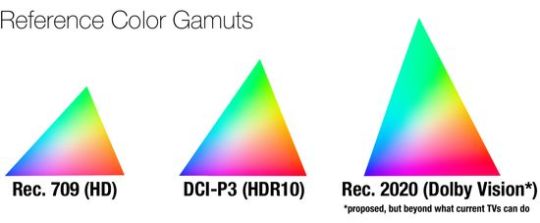
In fact, HDR TV expands the color gamut, increasing the saturation and color accuracy with the help of 12 bit color depth. In turn, increasing the range of contrast and color accuracy directly affect the realism and volume of the image. As a result, the screen displays a significantly brighter saturated image.

In general, new HDR technology includes three main components. In particular, it requires a TV with support for HDR format, a broadcast standard for transmitting HDR content and video in HDR format. Each of them, in turn, requires solving complex engineering problems. In addition, their matching also causes some problems.
Some features of HDR-technology
The distortion of the original directorial color and lighting solutions in the frame illustrates this situation well. For example, the creation of modern video content uses an extensive palette of colors within the digital cinematic DCI-P3 standard. But traditional SDR-TVs use a narrower standard Rec.709 that does not display many shades. As a result, the viewer perceives such content much paler. Therefore, TV versions often use special mastering to improve color accuracy. HDR-TVs do not have this limitation and can adjust the color scheme using their own algorithms. But, of course, it distorts the content originality. Therefore, engineers complement the video signal with metadata with information for converting an SDR image to HDR.
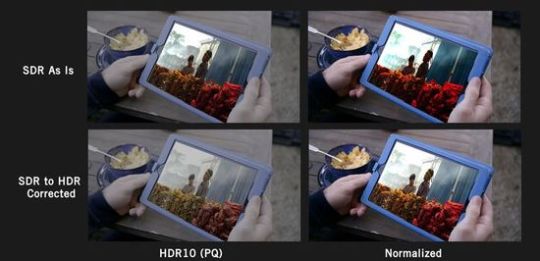
Metadata contains accurate information about the areas of the required dimming, brightening, adding red, purple, etc. Only in this case, TV will be able to accurately reproduce the original directorial content. But the transfer of metadata required an additional extension of the HDMI standard. As known, HDMI 2.0 supports the transfer of only static data. HDMI 2.0a is the first standard to support the transfer of dinamic metadata. HDMI 2.1 - is its further improvement. At CES 2019, LG introduced the first 4K OLED TVs with HDMI 2.1 support.
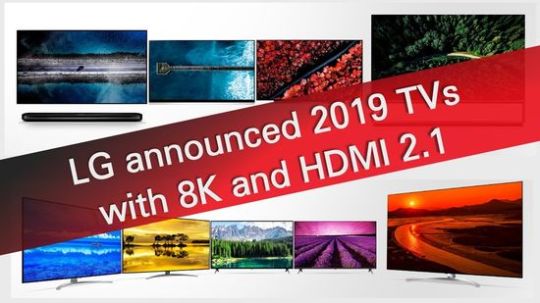
Content
Thus, technology requires HDR-content. Of course, the technology of its creation is much more complicated compared to SDR. HDR format requires the creation of metadata for each frame and their dynamic transmission for playback without distortion. Therefore, initially, the market offered a very limited HDR content. In fact, only Amazon, Netflix and Vudu services offered a small number of films in this format. However, Technicolor company developed and proposed a set of “Intelligent Tone Management” utilities for converting SDR content into pseudo-HDR. This technology has significantly optimized the restoration of original content, expanding the prospects of HDR. As a result, in the last years we see a rapid expansion of its range.
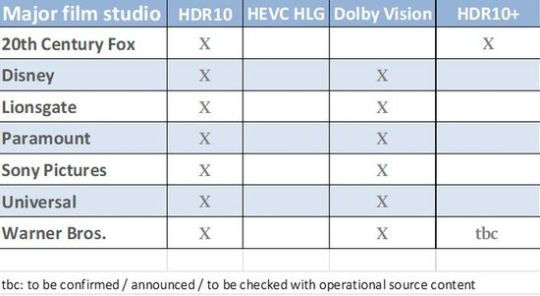
Technicolor was the first to use remastering to reformat popular black-and-white films, including the iconic The Wizard of Oz.
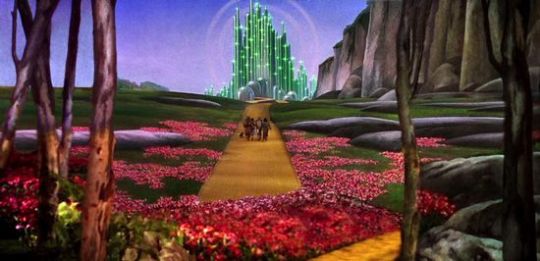
Further, company founded the UHD Alliance. Using their own development, Technicolor offered a platform broadcast with video on demand M-Go. Today Samsung has an exclusive agreement for its TVs, by analogy with Ultra HD content. The company is developing HDR technology for broadcast television and HDR-compatible set-top boxes. As known, Netflix is a pioneer in 4K / Ultra HD streaming. Today, it's actively working with HDR technology, promising the appearance of HDR - content by the end of this year. The company is also working on HDR-remastering of its own video, including Marco Polo.

After the full launch of this technology, the system will be able to determine the HDR compatibility of your TV and accordingly select the available content. Amazon company also announced its intention to create original TV content with HDR support.
Ultra HD Blu-ray
Of course, a high level of compression to stream high-quality video content significantly limits the broadcast. Blu-ray discs with their huge capacity have virtually no such limitations. Not surprisingly, the company also decided to join a new promising direction. Today, the Blu-ray Disc Manufacturers Association is working on new-generation 4K UHD Blu-ray discs with support for 4K, HDR, enhanced color reproduction and surround audio codecs, including Dolby Atmos and DTS: X. In addition, the new HDMI 2.0a standard significantly accelerated this process by expanding the range of models with HDR support, including new Blu-ray players and set-top boxes. Of course, today support for HDR is one of the important criteria for choosing a TV. 4K HDR LG OLED demo video perfectly illustrates the great features of HDR technology. Read the full article
#Blu-rayDiscManufacturersAssociation#Blu-rayplayers#DCI-P3#DolbyVision#dynamicmetadata#FALD#HDMI2.1#HDRContent#HDR10#HighDynamicRange#IntelligentToneManagement#Netflix#Rec.2020/2100#Rec.709#staticmetadata#Technicolor
0 notes